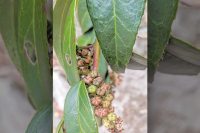Notes from a plant nerd: Invasive Plants
 There are a lot of misconceptions about invasive plants and how they should be handled. Adam Bigelow photo
There are a lot of misconceptions about invasive plants and how they should be handled. Adam Bigelow photo
I’ve been writing this column for over a year and a half and every plant that I have highlighted and celebrated evolved and co-evolved in the bioregion of Southern Appalachia.
And believe me, I am far from done telling you stories of the native plants we share this ecosystem with as there are so many beautiful and wonderful plants around us to share with you.
Which is one of the reasons that it perplexes me why so many people prefer to landscape their yards and public areas using plants that evolved in other parts of the world. These exotic plants can be beautiful and have characteristics sought after for landscaping needs, but then with so many native plants to choose from, there is always a replacement that would serve the landscape purpose and be native to this area.
This matters because of the intricate and fragile relationships insects and plants developed as they evolved together. Plants that did not grow up around here are mostly not seen as food by native insects in the same way as native plants have been and therefore don’t provide a home for caterpillars of moths and butterflies who like to eat the leaves of certain plants.
Some caterpillars are generalists, meaning that they can eat a variety of different plant species. Some are so specific in what they feed on that the butterfly is named after the plant it eats, for example, Pipevine Swallowtail (Battus philenor) and Pipevine, aka Dutchman’s Pipe (Isotrema macrophyllum), or its close relative the Spicebush Swallowtail (Papilio Troilus) whose caterpillars feed on the leaves of Spicebush (Lindera benzoin).
You’ve heard that the early bird gets the worm. More often it would be that the early bird gets the caterpillar, as caterpillars of all kinds make up the primary diet of songbirds, especially when they are raising their young. Some birds make upward of 1,500 trips a day to get food for their young, and Chickadees (Poecile spp.) require over 5,000 caterpillars to raise one clutch of chicks.
Related Items
While exotic plants can help native insects by providing nectar and pollen from their flowers, as they do not participate in this important part of energy transfer into the ecosystem, they don’t take as active a role as native plants do. This is a problem in your yard, where it causes a lot of harm when these exotic plants get spread around into natural areas. This is when exotic plants become invasive.
Invasive plants aren’t just those that take over large areas like Kudzu (Pueraria montana) and Privet (Ligusticum spp.). They are but two of many different invasive plants that cause ecological harm in the forest. A complete list for North Carolina can be found at ncwildflower.org/invasive-exotic-species-list.
One thing all of the plants that are considered invasive have in common is that they are all exotic and did not evolve in this bioregion. There are some native plants that did co-evolve with the other plants, insects, fungi, animals and other critters around us that are fast, aggressive growers that you might want to keep out of your veggie or flower beds. But, as they are native, by definition they can’t be considered invasive. All invasive plants are exotic plants.
And not all exotic plants are invasive. There are certainly some gentle players in the landscape and veggie garden that don’t cause harm. Or maybe just not yet. For this and many other reasons, I recommend planting and caring for native plants in your landscape while removing invasive plants, not as a matter of preference but for the birds and butterflies and other creatures who depend on them for life, and whom we share this life with.
(Adam Bigelow lives in Cullowhee. He leads weekly wildflower walks most Fridays and offers consultations and private group tours through Bigelow’s Botanical Excursions. This email address is being protected from spambots. You need JavaScript enabled to view it..)













